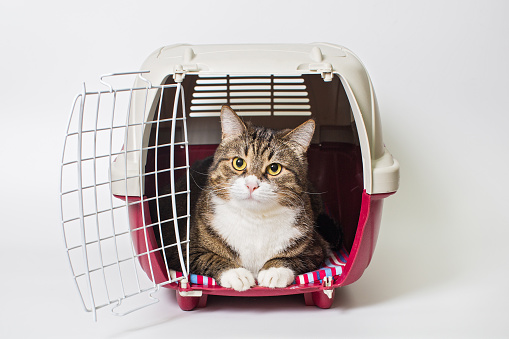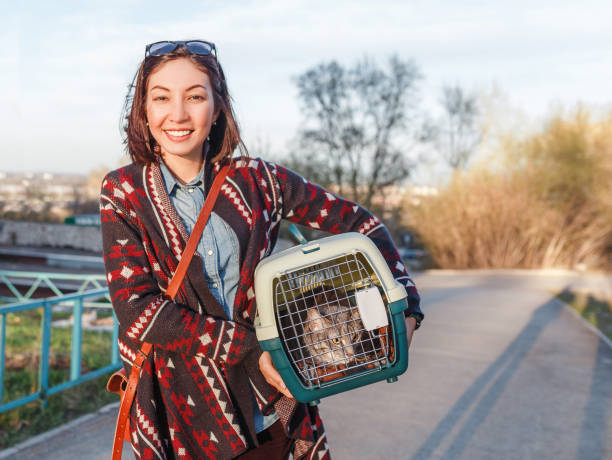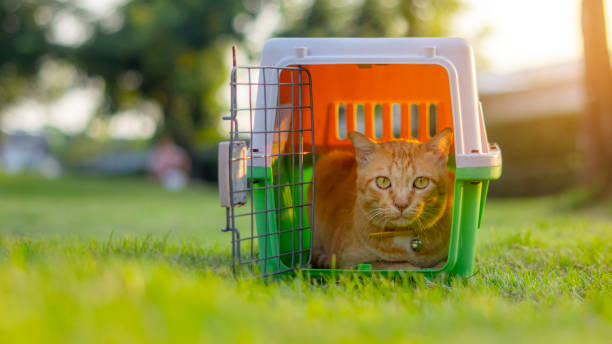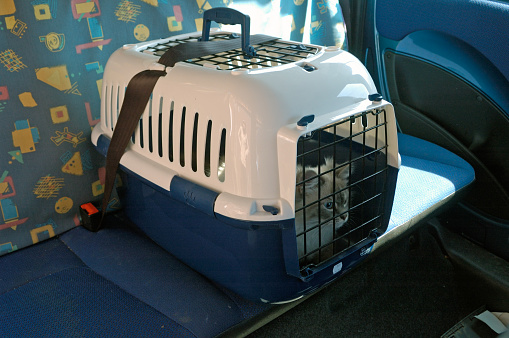
Crate training is a common type of training for dogs while in the puppy phase. Crate training a cat may sound a bit odd to you. Actually, cat crate training has a lot of benefits, as it will change the negative attitude that your feline friend is likely to have towards his/her crate. Why should you conduct cat crate training and how to do it- these are the questions that we will answer in today’s article.
Why to Crate Train Your Cat
Teaching your meowing friend to accept his/her carrier and even enjoy spending time inside, has many benefits.
You will be able to bring your cat to a veterinarian, a groomer, a daycare center, or otherwise bring him/her outside your home. Your paw friend should remain in a crate during a ride for both your and his/her safety. Pets who are not in a carrier may distract you while you are driving and cause dangerous situations. Also, they may get injured if you suddenly brake. Moreover, they can easily get out of the vehicle if a window is open, and fall into a dangerous situation on the street.
If an emergency situation occurs, and you have to leave your home immediately, you will be able to bring your paw friend out much easier if he/she is crate trained.
The crate is likely to provide your paw friend with a feeling of personal safe space. If you have guests, or there are too loud noises nearby, your cat may get anxious and try to hide. If he/she is crate-trained, he/she is likely to associate the crate with a private zone, that is comfortable and safe. You can just throw a blanket or a towel over the crate to make any stress triggers from the surroundings disappear.

How To Crate Train Your Cat
The first step that you should make prior to starting the training is choosing the right carrier for your little fellow.
Chose the Right Carrier
The crate should be a proper size so that your cat has enough space to lie down, stand up and turn around. It should be neither too small nor too large. Also, you may want to consider a crate with a removable top. Crates with such a design can make veterinarian checks less stressful for your cat, as the veterinarian will be able to examine your kitty without removing him/her from the crate (his/her safe place). Also, a removable top will provide a second exit option from the carrier, so that your paw friend feels more comfortable. Another feature of the cat carrier, you may want to consider is whether it should be soft or hard-sided. Both options have their advantages and disadvantages:
Soft-sided carriers:
Pros
They are cozier and your paw friend is likely to enjoy it more;
They can be folded and are easier to store;
They come in different colors and designs and look more attractive;
They are lighter and thus easier to carry;
They can be brought on a plane as carry-on luggage.
Cons
They are harder to clean;
They are less durable than hard-sided carriers;
Your cat might be able to tear the nylon part of the carrier if he/she becomes overly excited or anxious, and escape from it;
You may find it more difficult to zip up the carrier’s door if your cart is anxious and wants to get out;
They do not protect your cat as much as a hard-sided carrier does.
Hard-sided carriers:
Pros
They protect your cat better;
Your cat can not escape from the carrier;
They are easier to clean;
You can put your cat inside easier and close the carrier’s door quicker;
You can attach your kitty’s food and water supplies to it.
Cons
They are not so cozy and comfortable;
They are heavier;
They will take more place in your home.

Once you decide what type of crate/carrier will be the best option for you, you can move to the next step:
Introduce the Crate
We would recommend that you put the carrier at a place in your home that your kitty likes and has easy access to. Let the crate become a natural part of the environment so that your cat can explore it and get used to it. To make it more pleasant and welcoming, you could put a warm fluffy blanket inside. If the blanket has the scent of your kitty on it, this will make it automatically more appealing to him/her. You can try to gently rub the towel/blanket over your kitty’s body, to make it more attractive to him/her. Also, you can spray cat pheromones on the crate for a bigger effect. In the beginning, you should keep the door of the crate open or remove it completely. Just let your cat sniff around and investigate the crate.
Prepare Your Cat’s Favorite Treats
To reinforce your kitty’s interest in the crate, you should prepare his/her favorite treats that will be used as a reward. As we have already mentioned, cats are primarily motivated by food, so it plays a main role in the training process.
Use a Clicker
Monitor your kitty and notice when he/she looks at the crate, sniffs around, approaches it, touches it, or shows any kind of interest in it. Click to mark the behavior and immediately give your cat a reward to reinforce the behavior. The more positive experience you provide your cat with when he/she shows interest in the crate, the more motivated he/she will feel to keep doing it,
Repetition
Several repetitions are likely to motivate your cat enough so that he/she will want to spend more time around the crate or even inside it.
Close / Put the Carrier’s Door Again
Once your kitty shows that he/she feels comfortable near or inside the crate, you may try to put the door again. After your kitty goes inside, shut the door and keep it closed for a few seconds. You can start talking to your feline friend happy and calmly, to make him/her feel relaxed. After a few seconds, you should open the door and let your kitty get out. Reward him/her immediately to encourage him/her to spend more time in the crate voluntarily. Soon your paw friend will start pairing the time spent in the crate with his/her favorite treats. Although praising and petting are not as great cat motivators as food is, you still can use your exciting voice and praise your cat when he/she does the right thing.
Lift the Carrier
Repeat the steps above several times a day for 3-4 minutes. After a few weeks or sooner, it all depends on your cat, he/she may be able to spend 5-10 minutes inside the crate and remain calm during this time. At this point of the training, you can try to pick up the crate and hold it for a few seconds. Then reward your cat immediately. After a few repetitions, you can try carrying it around with your kitty inside. Increase the duration gradually and do not forget to reward your paw friend if he/she remains calm.
Riding in Your Car
The next step of the training process is to put the carrier in your car while your kitty is inside it and let it stay there for a minute or two. You can use once again your calm and happy voice to talk gently to your kitty. Then you should return the carrier home and let your paw friend go out. Reward him/her immediately. Once you notice that your cat remains calm while in the carrier, you can go visit your friends or relatives with your kitty so that he/she can get used to riding in a vehicle. Let your friends/relatives know that they can pet your cat and give him/her treats. The pleasant experience will contribute to the positive attitude in your cat toward car riding. Vet visits will not be the only thing that your little fellow will associate car riding with.

What You Should Keep In Mind During the Training
You should never rush things. Your cat may need more time to start feeling comfortable inside the crate. If your cat starts getting anxious, stop the session and repeat it later when he/she is already calm. You may need to take one step back and repeat it as many times as needed until your kitty feels comfortable with it.
Do not punish your cat and do not force him/her to go inside the crate. That way he/she will only develop a negative attitude toward the crate and will associate it with a terrible experience.
If your cat does not seem interested in the crate, you can place several treats inside to encourage him/her.
Occasionally, you can take your kitty for rides to different locations, so that he/she does not pair car riding with vet checks only.
Make sure that you have the right carrier for your kitty. If he/she still does not seem to like it, you may need to consider switching it for a different design or relocating it.












